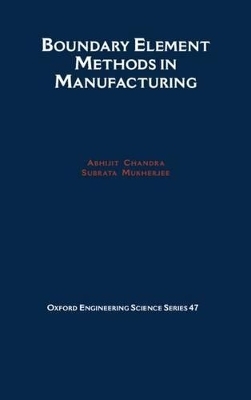
Boundary Element Methods in Manufacturing
Seiten
1997
Oxford University Press Inc (Verlag)
978-0-19-507921-0 (ISBN)
Oxford University Press Inc (Verlag)
978-0-19-507921-0 (ISBN)
Numerical simulation of manufacturing processes, and its integration into the design cycle, are the dual themes of this book. The computational method of choice here is the boundary element method (BEM). Detailed discussions of forming, casting, machining and grinding process modelling are included in this book.
Manufacturing processes have existed, in some form, since the dawn of civilization. Modelling and numerical simulation of mechanics of such processes, however, are of fairly recent vintage; made possible, mainly by improved understanding of the fundamental mechanics and physics of these processes as well as by the availability of ever more powerful computers. Our capabilities of designing manufacturing processes, however, significantly lag behind our abilities in simulating such processes. In fact, research in the area of design of manufacturing processes is barely a decade old.
Analysis of manufacturing processes, and its integration into the design cycle of these processes, are the dual themes of this book. The boundary element method (BEM) is the computational method of choice. This versatile and powerful method has enjoyed extensive development during the last two decades and has been applied to virtually all areas of engieering mechanics (both linear and nonlinear) as well as in other areas.
The BEM infra-structure is presented in Chapters 2, 3, and 4. Chapters 2 and 3, respectively provide reviews of the fundamentals of nonlinear and thermal problems. Material and geometric nonlinearities are ubiquitous in manufacturing processes such as forming and machining while thermal issues play significant roles in casting and machining processes. Chapter 4 discusses design sensitivity analysis, and provides an avenue for utilizing insights gained from analysis toward design synthesis of manufacturing processes. Chapters 5 through 9 are devoted to detailed discussions of a broad range of manufacturing processes - forming, solidification, machining, and ceramic grinding.
The unique features of this book are its emphasis on numerical simulation as well as on design of manufacturing processes, and the use of the boundary element method as the computational method of choice.
Manufacturing processes have existed, in some form, since the dawn of civilization. Modelling and numerical simulation of mechanics of such processes, however, are of fairly recent vintage; made possible, mainly by improved understanding of the fundamental mechanics and physics of these processes as well as by the availability of ever more powerful computers. Our capabilities of designing manufacturing processes, however, significantly lag behind our abilities in simulating such processes. In fact, research in the area of design of manufacturing processes is barely a decade old.
Analysis of manufacturing processes, and its integration into the design cycle of these processes, are the dual themes of this book. The boundary element method (BEM) is the computational method of choice. This versatile and powerful method has enjoyed extensive development during the last two decades and has been applied to virtually all areas of engieering mechanics (both linear and nonlinear) as well as in other areas.
The BEM infra-structure is presented in Chapters 2, 3, and 4. Chapters 2 and 3, respectively provide reviews of the fundamentals of nonlinear and thermal problems. Material and geometric nonlinearities are ubiquitous in manufacturing processes such as forming and machining while thermal issues play significant roles in casting and machining processes. Chapter 4 discusses design sensitivity analysis, and provides an avenue for utilizing insights gained from analysis toward design synthesis of manufacturing processes. Chapters 5 through 9 are devoted to detailed discussions of a broad range of manufacturing processes - forming, solidification, machining, and ceramic grinding.
The unique features of this book are its emphasis on numerical simulation as well as on design of manufacturing processes, and the use of the boundary element method as the computational method of choice.
1. Introduction ; 2. Problems Involving Large Strains and Rotations ; 3. Thermal Problems ; 4. Design Sensitivities and Optimization ; 5. Planar Forming Processes ; 6. Axisymmetric Forming Processes ; 7. Solidification Processes ; 8. Machining Processes ; 9. Integral Equations for Ceramic Grinding Processes
| Erscheint lt. Verlag | 12.6.1997 |
|---|---|
| Reihe/Serie | Oxford Engineering Science Series ; 47 |
| Zusatzinfo | numerous line figures, tables |
| Verlagsort | New York |
| Sprache | englisch |
| Maße | 160 x 241 mm |
| Gewicht | 933 g |
| Themenwelt | Mathematik / Informatik ► Mathematik ► Angewandte Mathematik |
| Naturwissenschaften ► Physik / Astronomie ► Angewandte Physik | |
| Technik ► Maschinenbau | |
| ISBN-10 | 0-19-507921-3 / 0195079213 |
| ISBN-13 | 978-0-19-507921-0 / 9780195079210 |
| Zustand | Neuware |
| Haben Sie eine Frage zum Produkt? |
Mehr entdecken
aus dem Bereich
aus dem Bereich
Buch | Softcover (2024)
Springer Vieweg (Verlag)
44,99 €
Anwendungen und Theorie von Funktionen, Distributionen und Tensoren
Buch | Softcover (2023)
De Gruyter Oldenbourg (Verlag)
69,95 €


